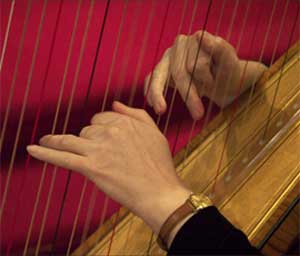
|
|
Learn to Play the HarpJenny has several years teaching experience, both privately and at various schools. Her pupils have a good success rate in Associated Board exams (currently 85% Distinctions) and many have given public performances of a high standard. As well as teaching in schools, Jenny teaches from home and is ready to teach young and old! Lessons are usually at Jenny’s house in Newbury and last 45 minutes to an hour. Clarsachs cost about £1000 or more new. Pedal harps can cost anything from £5000 to £30,000. Secondhand harps are available. It is best to hire a harp at first and learn to play something before making such a major purchase. Harps can be hired from From time to time, it will be necessary to replace strings on the harp. The highest strings cost about £5 and the bass strings can cost up to £20 each. A full set of strings can cost £200 to £400 You can begin to learn the harp at almost any age. The most important thing is enthusiasm to learn. Very small hands may not reach everything. It is probably better not to start younger than 7. Old hands may be stiff and one should be aware that playing the harp is a muscular business, needing flexibility in the fingers and thumbs, nevertheless enthusiasm can overcome stiffness! Your first harp lessonThe first lesson is about learning a good playing action and position and concentrates on exercises to practise this. Later on the lesson will normally cover an exercise, a study and two pieces as well as practising sight-reading and aural as appropriate. Good progress depends on regular practice, preferably every day. About half an hour a day is good for the early stages. More advanced players will need more time. Exams are set by the Associated Board and by Trinity College of Music at Grades I to VIII. More advanced exams are also available. Where to play once you have learntOrchestral playing is not easy and one needs a standard of probably Grade VI or so, but youth orchestras are generally short of harpists as are most amateur orchestras. There is chamber music for harp though the famous music is difficult for all players. There are competitive festivals with harp classes, particularly around London.
|

Frequently Asked QuestionsHow do you move the harp around? Clarsachs are not a problem to transport. Pedal harps will go in the larger estate cars. Special harp trolleys are available to move the harp from the car to wherever. It’s probably impossible to take your pedal harp on the bus! Who tunes the harp? The harpist tunes the harp. It is good to tune the harp every time it is played, as violinists do, but it is possible to keep the harp reasonably in tune by tuning every two or three days. Electronic tuners make this much easier. Do I need to read music? Music reading can be learnt at the same time as starting harp lessons. Progress is much faster if the pupil already reads music and it is necessary to read it eventually. Will I get blisters? Blisters occur when the amount of practising increases, so a beginner may get blisters. A more experienced player may also get blisters if the amount of practising suddenly increases, before an exam or a concert, for example. Some skins are more susceptible to blistering than others. Can I buy the music at my local music shop? Probably not. Harp music is specialised and usually ordered by mail order. It tends to be more expensive than more popular music. The great teacher Henriette Renié said ‘it is necessary first to love the harp’ and certainly the arguments against learning the harp are very strong – everything is awkward and expensive. One has to love the sound of the harp and have a strong urge to make it sound for oneself. |
